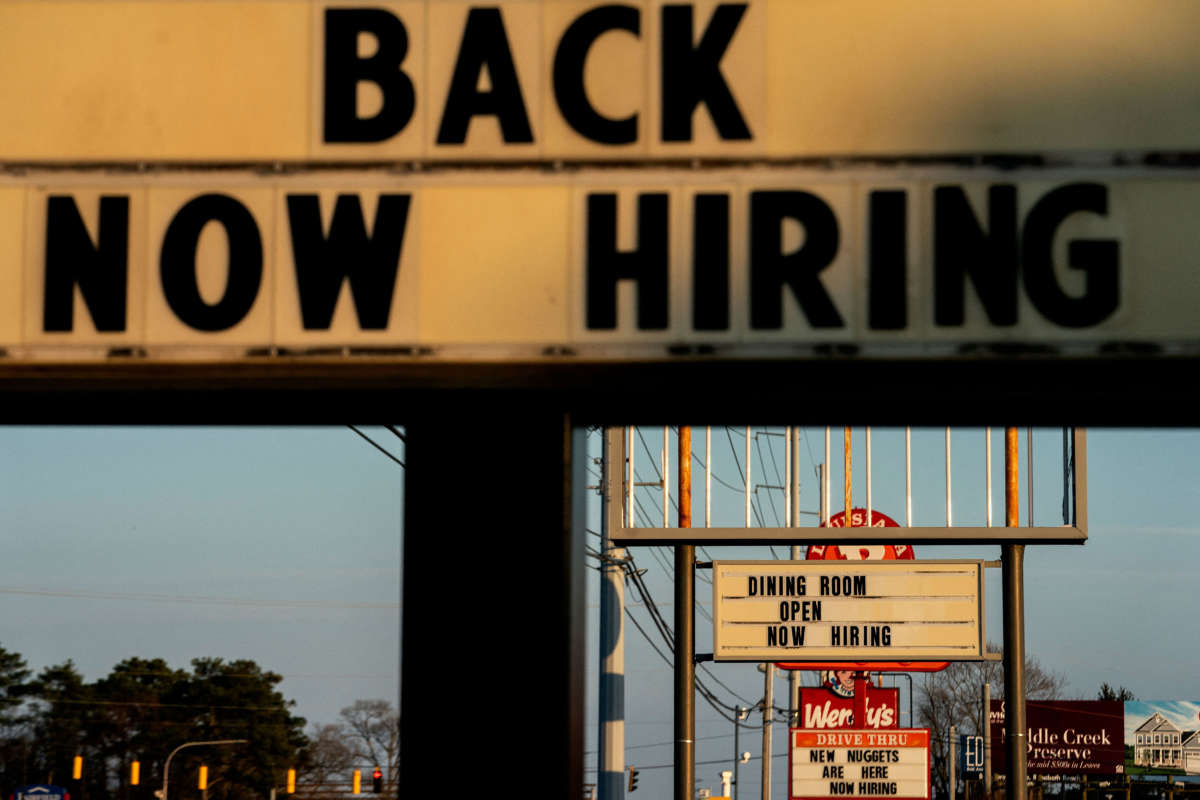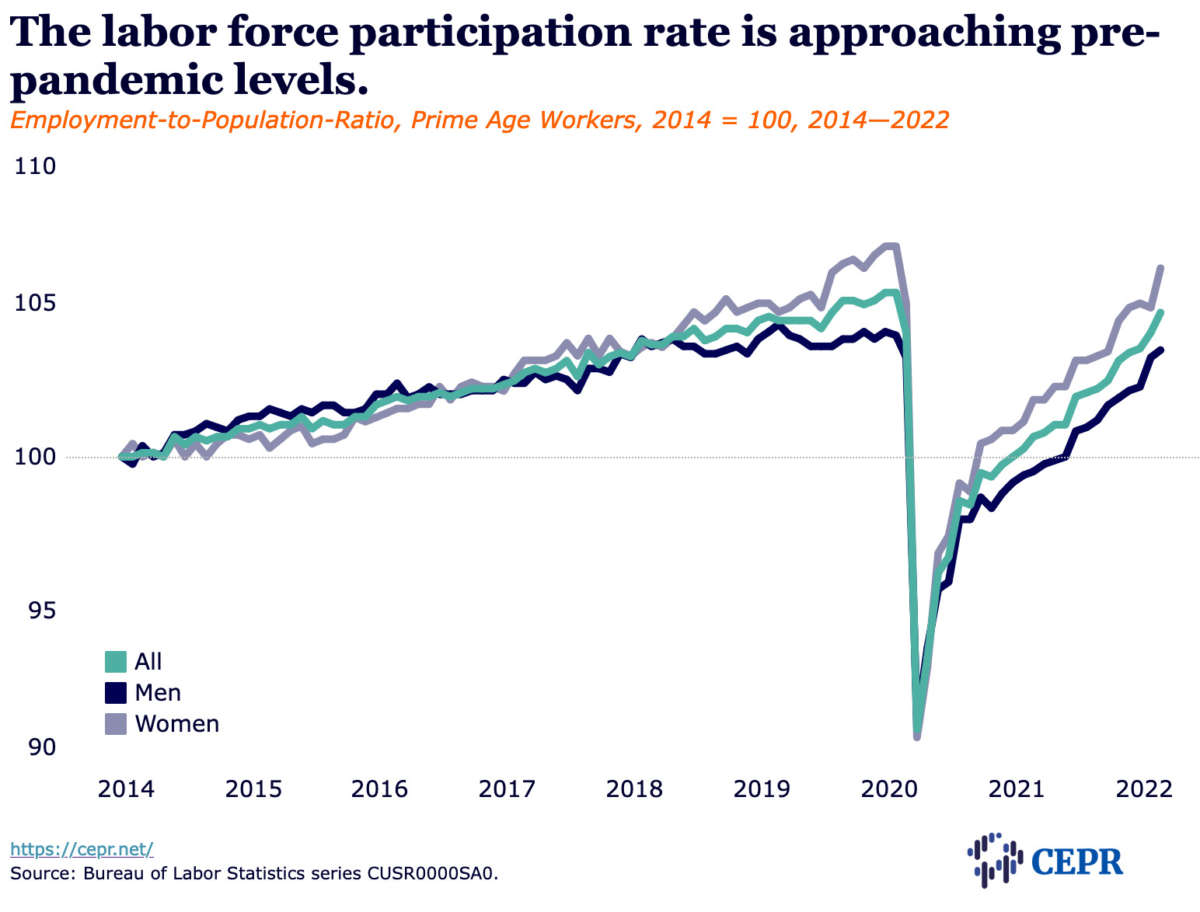The economy added 431,000 jobs in March, in line with expectations. Revisions to the prior two months data added 95,000 jobs to January and February growth, bringing the three month average to 562,000. Total employment is now down by 1.6 million from the pre-pandemic level. The strong job growth brought unemployment down to 3.6 percent, just 0.1 percentage point below its pre-recession low.
Employment Closes in on Pre-Pandemic Levels
The rise in employment in March left total employment at 1.6 million jobs below its pre-pandemic level, less than three months of growth at its recent pace. Private sector employment is down by just 870,000 jobs from its February 2020 level.
Evidence of Modest Slowing in Wage Growth
There was some evidence of a slight slowdown in wage growth which should lessen concerns over inflation. The average hourly wage was up 5.6 percent year-over-year, but increased at a 5.1 percent annual rate when comparing the last three months (January–March) with the prior three months (October–December).
There is a similar story with the pay of production and nonsupervisory workers, which increased 6.7 percent year-over-year, but rose at just a 6.0 percent annual rate when comparing the last three months with the prior three months. Pay for production workers in leisure and hospitality, which had been soaring, slowed from a 14.9 percent year-over-year increase, to an 8.3 percent annual rate when comparing the last three months, with the prior three months.
Average Workweek Declines Slightly in March
The length of the average workweek fell by 0.1 hour in March. This left the index of aggregate hours unchanged, despite the strong job growth in the month. This is consistent with the labor shortage becoming less severe. Employers are finding it easier to hire workers so they have less need to have workers put in more hours.
Sectors That Have Problems Raising Wages Continue to Be Hard Hit
The sectors that have trouble raising pay to compete for workers continue to be well below pre-pandemic employment levels. Employment in nursing homes fell 2,500, down 241,000 (15.2 percent) from its pre-pandemic level. Jobs in child care rose by 6,000 in March, but are still down by 117,000 (11.1 percent) from pre-recession levels.
Local governments added 20,000 jobs in March, but employment is still down 612,000 (4.2 percent) from pre-recession levels. The public sector now accounts for almost half of the job falloff from pre-pandemic levels.
Sharp Drop in the Percentage of Unemployment Due to Voluntary Quits
Another piece of data in this report that is consistent with a cooling labor market is a drop in the share of unemployment due to voluntary quits. The share fell sharply from 15.1 percent in February to 13.0 percent in March. These data are erratic, but this drop would be consistent with some weakening of the labor market.
Self-Employment Continues to Be Far Above Pre-Pandemic Levels
The number of people who reported being self-employed (both incorporated and unincorporated) in March was 618,000 above the average for 2019. The fact that self-employment remains high, even as the labor market has tightened enormously, indicates that self-employment is a choice rather than an act of desperation. If the rise in self-employment is added in, private sector jobs would be just 250,000 below their pre-pandemic levels.
Restaurant Industry Leads Job Gainers
The restaurant industry added 61,300 jobs in March but this still left employment 820,000 (6.6 percent) below its pre-pandemic level. This is striking since real restaurant sales are actually above pre-pandemic levels indicating large gains in productivity. Other big job gainers were retail, which added 49,000 jobs; manufacturing, which added 38,000; and construction, which added 19,000. Employment in retail and construction is now above the pre-pandemic level. Manufacturing employment is still down by just over 1.0 percent.
The motion picture industry added 8,400 jobs in March, bringing its gains over the last year to 93,100, an increase of almost 30 percent. This sector had been one of the hardest hit by the pandemic; employment is now down by less than 3.0 percent from its February 2020 level.
Black Unemployment Rate Falls Sharply
The unemployment rate for Blacks fell 0.4 percentage points to 6.2 percent, 0.8 percentage points above pre-recession low. It is still almost double the 3.2 percent unemployment rate for whites. The unemployment rate for Hispanics edged down from 4.4 percent to 4.2 percent.
The unemployment rate for Asian Americans fell to 2.8 percent, slightly below the unemployment rate for whites. This was the normal pattern before the pandemic.
Employment Rate for Prime Age Workers Rises by 0.5 Percentage Points
The employment rate for prime age workers (ages 25 to 54) rose 0.5 percentage points in March to 80.0 percent. This was a level not reached following the Great Recession until August 2019, and it is just 0.5 percentage points below the pre-pandemic peak.
Almost 900,000 People Still Report Being Out of the Labor Force Due to COVID-19
In March, 874,000 people reported being out of the labor force because of COVID-19. These are people who report being either sick themselves, caring for a family member who is sick, or not looking for work because they are worried about catching COVID-19. The figure is down from 1.2 million in February, but still more than 0.5 percent of the labor force.
Another Very Solid Report
The March report showed the labor market continues to improve, with modest evidence that the labor shortages in some areas are being alleviated. The reduction in the length of the average workweek is consistent with a story where employers are better able to hire the workers they need. The fall in the percentage of unemployment due to quits indicates workers may be somewhat less optimistic about their job prospects. And, the slower wage growth, especially in the sectors that had seen the most rapid run-ups, should mean some reduction in inflationary pressures.
Media that fights fascism
Truthout is funded almost entirely by readers — that’s why we can speak truth to power and cut against the mainstream narrative. But independent journalists at Truthout face mounting political repression under Trump.
We rely on your support to survive McCarthyist censorship. Please make a tax-deductible one-time or monthly donation.

